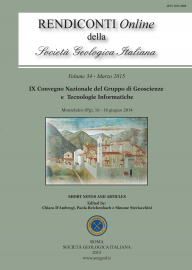
Lithological variability of the Mortisa landslide body: assessing geomorphological evolution and numerical modelling through a stochastic approach
Giulia Bossi (a,b), Lisa Borgatti (a), Matteo Mantovani (b), Gianluca Marcato (b), Guido Gottardi (a) & Alessandro Pasuto (b)
(a) Department of Civil, Chemical, Environmental and Materials Engineering DICAM, Alma Mater Studiorium Università di Bologna, Bologna, Italy. E-mail: giulia.bossi@irpi.cnr.it
(b) CNR-IRPI – National Research Council of Italy, Research Institute for Geo-Hydrological Protection, Padua, Italy.
Volume: 34/2015
Pages: 54-57
Abstract
The Mortisa landslide is located in the urban area of Cortina d'Ampezzo, north-east Italy. The landslide unit consists of three mudslides; the affected area is 3500 m long, stretching from 1750 to 1300 m a.s.l. The landslide has been investigated since 1998 as its track crosses a national route and some buildings have been severely damaged by the movements.
Through radiocarbon dating it was possible to reconstruct the dynamic of the events that led to the formation of the present-day Mortisa slope. The landslide body is composed by interdigitated layers of gravel in a silty clay matrix originated from subsequent earth and debris flows events since the Lateglacial.
To assess the stability conditions of the Mortisa landslide via numerical modelling it is crucial to consider the mechanical influence of the gravel lenses in the dynamic of the whole landslide body. However, their position is almost unknown inside the clay matrix with just some certain positions, where stratigraphic data are available. Therefore, in order to calibrate the model on the monitoring data through back analysis, a new procedure has been implemented. A new code permits to generate stochastically several soil configurations which are automatically elaborated by the commercial software FLAC. The results are organized and filtered based on the monitoring data, hence it is possible to select the model that fits the data best. In this way it it possible to obtain a sound back-analysis model of the Mortisa landslide, to be used in order to design countermeasure works and mitigate the risk associated with the phenomenon.
Keywords
Get Full Text